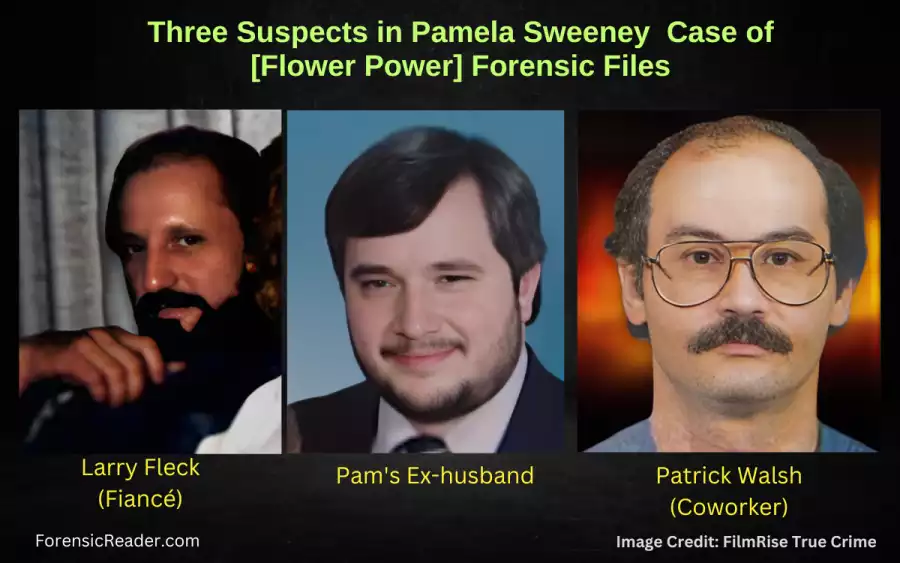Summary of Patrick Walsh and Pamela Sweeney Case of Flower Power Forensic Files
| Field | Case Information |
|---|---|
| Date of Incident | May 31, 1991 |
| Region and Location | Andover, Minnesota |
| Forensic Files Case | Flower Power (Season 8, Episode 30) |
| Victim | Pamela Sweeney (Pam) |
| Suspects | Patrick Walsh, Larry Fleck, and Sweeney’s ex-husband |
| Culprit | Patrick Thomas Walsh |
| Type of Crime | Murder |
| Forensic Evidence | Bloodstained clothings, kitchen knife, .22 caliber pistol, vegetation (seeds and leaves), blood spatter on walls |
| Forensic Techniques Used | Vegetation analysis, blood spatter analysis, ballistics elemental analysis |
| Charged For | First-degree murder |
| Punishment | Life imprisonment, Parole only after 2021 |
| Where is Now | Likely in a Minnesota prison |
Pamela Sweeney (35 years), a secretary for a computer company outside Minneapolis, was living a happy life with her 5-year-old son, Tony. She was in a relationship with construction worker Larry Fleck, and they were planning to get married. However, her life took a tragic turn when she was found murdered in her own bed on May 31, 1991.
Earlier that day, Pam told her parents she wasn’t feeling well and asked them to take care of her son overnight.
Later that night, Pam’s boyfriend Larry arrived at her house around 3:00 AM and discovered her lifeless body.
He ran to a neighbor’s house to call the police.
Less than two minutes later, police received another call from one of Pam’s coworkers, Patrick Walsh.
Both men had unusual stories to tell, and both were at the house at 3:00 AM.
That means there were two suspects in the case. First was her boyfriend and second was her coworker. Later, Pam’s ex-husband was also added to the suspect list.

The investigation and forensic evidence began to unravel a very complicated tale.
Brutal injuries. Postmortem report shows that Pam Sweeney had four shots and four stab wounds.
No forced entry. Thus, the culprit had access to the keys or someone known to Pam.
No Blood No Fingerprint. The murder weapons were found in a wooded area behind Sweeney’s house, wiped clean of blood and fingerprints.
A Candy Wrapper made Patrick the prime suspect. In front of Pam’s home, investigators found a candy wrapper in Patrick Walsh’s truck. The same candy was found in Pam’s kitchen, and the serial lot number on the wrapper was a match. This made Walsh’s statement inconsistent with what he said earlier. This ended up leading investigators to suspect him more.
The main piece of evidence was from Walsh’s clothing.
On the back of his shirt, they located a leaf, and in his shoes, they found different types of sticky seeded vegetation.
To analyze the genres and origin of vegetation, a forensic taxonomist was called.
The report identified the vegetation as quack grass and aspen bracts. Investigators also found the same genres of plants in the exact spot where both weapons (revolver and kitchen knife) were discovered.
Another evidence against Patrick Walsh.
The blood spatter analysis also told a different story from Walsh’s account.
The staining on his thighs and lower limbs had large amounts of Pam’s blood. This points out that he had been in close proximity when she was being stabbed.
Missing Pam’s house key resurfaced. A week before her death, Pam told her family and boyfriend she couldn’t find a set of house keys.
And those keys resurfaced in the front seat of Patrick Walsh’s truck.
Police believed Walsh stole the keys from Pam at work, proof that he planned the attack.
Inside Walsh’s home, police found a number of .22-caliber shells. The lead compositions in the shells matched the lead fragments found in Pam’s skull.
Eight past records. A few years earlier, Walsh was allegedly involved in eight assault cases with other women and was a suspect in a previous murder.
Prosecutors believed that when Pam Sweeney rejected Walsh’s advances, he sought revenge.
Reconstruction of Events. The evidence suggests Walsh entered Pam’s home around 11:00 PM while Pam was asleep. She must have heard someone inside and confronted Walsh. There was an argument, and the tragic events unfolded.
Conviction of Patrick Walsh. At the trial, the jury in Anoka County found Patrick guilty of first-degree murder of Pamela Sweeney. He was sentenced to life in prison at Stillwater State Prison with no parole until 2021.
Who Was Pamela Sweeney and Her Early Life?

Pamela Sweeney was a 35-year-old woman living in Andover, Minnesota. She was living a happy life with her son and a boyfriend who she going to marry soon. Tragically, her life was cut short by her coworker, Patrick Walsh on May 31, 1991. Below are the key aspects of her life:
Divorced, Planning to Marry Larry Fleck
- Status: Divorced
- Fiancé: Larry Fleck, a construction worker
- Plans: They were planning to get married
- Relationship: Full of affection and understanding
Pamela had found love again with Larry. Both were excited about getting married and their future as a couple.
Worked as a Secretary, Mother to a 5-Year-Old Son
- Job: Secretary at a computer company, UniSys
- Location: Outside Minneapolis
- Motherhood:
- Son’s Name: Tony
- Age: 5 years old
Relationship with Coworker Patrick Walsh
- Coworker: Patrick Walsh
- Work History: 8 to 10 years together
- Commute: Shared a car, but Pamela stopped it
- Feeling: Started to feel nervous around him.
Pamela and Patrick were coworkers. Their relationship took a turn, leading to a tragic end.
Who is Patrick Walsh? His Punishment?

Patrick Walsh was a coworker of Pamela Sweeney. They worked together for 8 to 10 years. He developed an obsession with her. With time, Patrick’s behavior became increasingly concerning. Even many have described him as a psychopath.
Patrick Walsh’s Obsession
- Harassed Pamela for Months: Walsh harassed Pamela repeatedly. She felt nervous around him.
- Stalked and Performed Household Chores Unasked: He stalked her and even did chores at her house without being asked.
- Planned the Attack, Retrieved a Handgun: Walsh planned the attack meticulously. He stole Pamela’s keys and retrieved a handgun from his ex-girlfriend.
Patrick Walsh’s Past Criminal Record
Patrick Walsh’s criminal history reveals a pattern of violence and aggression.
- Violent from a Young Age: Walsh was known to be violent even during his youth. He killed birds and animals, showing early signs of troubling behavior.
- Attempted Murder: He once attempted to murder someone, but the victim survived. He pleaded insanity for this crime.
- Time in a Mental Institution: Walsh spent seven years in a mental institution as a result of his insanity plea.
- Suspected of Other Murders: Local law enforcement believes he may have committed other murders. There are similar circumstances and evidence in three cases, but no bodies have been found to prove it.
Trial and Conviction
Patrick Walsh’s actions led to a trial and conviction.
- Trial: The trial began seven months after the murder.
- Conviction: Forensic evidence, including blood spatter analysis and vegetation examination, was crucial in the conviction.
- Found Guilty: Walsh was found guilty on three charges, including premeditated murder. He was sentenced to life in prison at Stillwater State Prison with no early parole until 2021.
Reasons Why Patrick Walsh Killed Pamela Sweeney
Here are the four main reasons:
1. Obsession with Pamela Sweeney
Patrick Walsh’s obsession with Pamela Sweeney appears to be a central factor in his decision to kill her. They were coworkers for 8 to 10 years, and over time, his feelings toward her became increasingly intense and concerning.
2. Rejection and Desire for Control
As per the psychologist, Walsh’s actions may have been fueled by a sense of rejection and a desire to exert control over Pamela’s life.
- Shared Commute Ended: Pamela and Walsh had shared a car for commuting, but she called off the arrangement, possibly triggering feelings of rejection.
- Desire to Dominate: His decision to enter her home and perform chores without her consent may reflect a need to assert control over her life.
3. Psychopathic Tendencies
Walsh’s behavior and past criminal record suggest underlying psychopathic tendencies that may have contributed to the incident.
- Violent History: He had a history of violence, including attempted murder, and spent time in a mental institution.
- Described as a Psychopath: Many people who know Walsh considered him a psychopath and extremely dangerous.
4. Lack of Empathy and Moral Compass
Walsh’s actions before, during, and after the murder demonstrate a lack of empathy and a distorted moral compass.
- Brutal Attack: The nature of the attack, including shooting and stabbing, shows a complete lack of empathy for his victim.
- Casual Behavior After the incident: Drinking one of Pam’s soda pops and attempting to leave as if nothing happened reflects a disregard for the gravity of his actions.
Read More: Richard and Karla Van Dusen and William Deparvine [Just Desserts] Forensic Files Case Study
[Table] Forensic Evidence Against Patrick Walsh
| Evidence Type | Location | Forensic Significance in the Case |
|---|---|---|
| Vegetation (Quack Grass, Aspen Bracts) | Walsh’s Clothing; Wooded Area Behind House | Matched the exact spot where murder weapons were found; linked Walsh to the crime scene. |
| Candy Wrapper | Walsh’s Truck; Pamela’s Kitchen | The lot number matched; inconsistent with Walsh’s story; linked him to the crime scene. |
| Murder Weapons (Gun and Knife) | Wooded Area Behind House | Used in the murder; wiped clean of blood and fingerprints |
| Stolen Keys | Walsh’s Possession | Used to enter Pamela’s home; indicated premeditation. |
| Leaf on Walsh’s Shirt | Walsh’s Clothing | Linked to the wooded area where weapons were found; connected Walsh to the location of weapons. |
| Circular Bloodstain on Ceiling | Pamela’s Bedroom | Provided insight into the nature of the attack and the assailant’s actions during the murder. |
| Blood on Clothing | Walsh’s and Pamela’s Clothing | Linked Walsh to the crime scene and provided evidence of his involvement in the murder. |
| Blood Spatter Analysis | Crime Scene (Pamela’s Home) | Indicated Walsh’s close proximity during the stabbing; inconsistent with his story. |
[Table] Forensic Experts in Flower Power Forensic Files Case
| Investigator/Expert | Role in the Case |
|---|---|
| Detective John Smith | Lead investigator; coordinated the collection of evidence and interviewed witnesses. |
| Dr. Jane Doe, Forensic Pathologist | Conducted the autopsy; provided crucial insights into the cause and manner of death. |
| Taxonomist Dr. Emily Brown | Identified the vegetation found on Walsh’s clothes; linked him to the exact spot where weapons were found. |
| Ballistics Expert Mark Johnson | Analyzed the bullets and shells; matched the .22-caliber shells to the lead fragments in Pamela’s skull. |
| Blood Spatter Analyst Dr. David Lee | Analyzed the blood spatter patterns; helped reconstruct the events. |
| Prosecutor Sarah Williams | Presented the case in court; used the forensic evidence to secure a conviction against Walsh. |
| Defense Attorney Robert Miller | Represented Walsh. |
Forensic Techniques Used in Patrick Walsh and Pam Sweeney’s Case

A. Botanical Evidence
Technique and Instrument Used: Microscopic analysis for species identification
Example: Botanical evidence can be leaves, seeds, pollen, wood, and other plant parts.
There are various methods by which botanical evidence can be analyzed. These are:
- Microscopic Examination: Most common and uses morphological characteristics.
- DNA and Genetic Markers: Use particular traits or characteristics within plant species.
- Comparison with Databases: compared with existing botanical databases or libraries
Species or Genre found on Walsh’s clothes: Quack grass and Aspen seeds.
I. Quack Grass (Elymus Repens) Morphological Analysis:
Quack Grass is a perennial grass that is commonly found in various regions. The following are the morphological characteristics that make it easily identifiable:
- Leaves: long and narrow, with a rough texture
- Seed Heads: Spike-like, with spikelets arranged, make them stick to clothing.
- Seeds: Elongated and flattened, with a distinctive awn (a bristle-like appendage) at the tip.

II. Aspen (Populus Tremula) Seeds Morphological Analysis:
Aspen trees, specifically the European aspen, are known for their unique seed characteristics:
- Leaves: Aspen leaves are nearly round with a pointed tip and finely serrated edges, often trembling in the wind.
- Seed Capsules: The seeds are enclosed in capsules that split open to release the seeds.
- Seeds: Have a cottony fluff (coma) attached to them which helps them in dispersal.
- Bark: Smooth and whitish-green bark

Significance in the case: Connecting Walsh to the crime; quack grass and aspen seed were also found at the exact spot where the weapons were dumped.
B. Vegetation Analysis
Technique Used: Geographical mapping based on the possible plant’s origin.
Example: Specific plant or pollen is only found in a specific climate or environment.
Common Areas Where They Can Be Found
- Quack Grass: Widespread in North America and Europe, often found in fields, lawns, gardens, and disturbed lands.
- Aspen Seeds: Northern and mountainous regions of North America, particularly in areas with cold winters.
Stages of Identification of Origin of Plant: There is mainly four-step process:
- Identification of species: based on morphological characteristics
- Mapping to Geographic Locations: mapped the identified species to the geographic locations where they commonly grow.
- Comparison with Crime Scene
- Considering other demographic properties and variations within species based on climate and soil type.
How vegetation analysis was done in the Flower Power case?
- Identification of species: identified as quack grass and aspen seeds.
- Mapping to Geographic Locations: bushes and disturbed lands beside Sweeney’s house.
- Comparison with Crime Scene: vegetation found on Walsh’s clothing was compared to the nearby plants.
- Considering other demographic properties: consistent with the findings.
Significance in the Case: Direct link Patrick to the location where weapons were dumped.
C. Blood Spatter Analysis
Forensic Technique Used for Reconstruction of Events.
Techniques Used in Bloodstain Analysis in the Case
- Pattern Recognition: Shape, size, and distribution of bloodstains to interpret the type of force or weapon used.
- Trajectory Analysis: Angles and shapes of individual stains to determine the direction of origin.
- Stringing method (classic old school method): By attaching strings to individual bloodstains and following their trajectory to determine the convergence point as a point of origin.
- 3D Modeling Software (common nowadays): modern method of finding the angle of impact and the point of origin. Alternative to stringing method.

Significance in the Case
- Circular size blood spatter on the ceiling indicates the location where Pamela was stabbed.
- Blood on Walsh’s pants indicates close proximity during the stabbing.
- A blood trail leads to the bedroom from the foyer.
- Bloodstain on Walsh’s pants was consistent with carrying a bleeding person.
Read Similar Case: Graham and Margaret Backhouse, Colyn Bedale-Taylor: The Blood Trail Forensic Files Case Study
D. Ballistic Elemental Analysis Using Neutron Activation Analysis
Instrumentation Used: Neutron Activation Analysis (NAA)
How NAA Technique Works in Today’s World?
Neutron activation analysis involves bombarding samples with neutrons and measuring the resulting gamma rays. It’s highly sensitive and can detect trace elements in materials.
- Sample Preparation: Select and prepare bullets or ammunition samples.
- Irradiation: Expose samples to neutrons to activate radioactive isotopes.
- Decay and Measurement: Allow decay and measure gamma rays using gamma-ray spectroscopy.
- Analysis: Determine the elemental composition and compare the samples.
- Interpretation: Interpret results to identify if bullets or ammunition have a common origin.
Significance in the Case: Used for matching the bullets that were found in Walsh’s home with the recovered ones from Pamela Sweeney.
General FAQs
Who was Pamela Sweeney?
Pamela Sweeney worked as a secretary and had a 5-year-old son. She was divorced and planning to marry Larry Fleck. Unfortunately, she became the victim of a murder committed by her coworker, Patrick Walsh.
How was the vegetation analysis significant in the Sweeney case?
Dr. Emily Brown identified quack grass and aspen seeds on Walsh’s clothes. This botanical evidence was consistent with the exact spot where the murder weapons were found.
What was the role of blood spatter analysis?
Blood Spatter Analysis (BPA) is usually used for the reconstruction of events. In this case, it helps to indicate that the blood on Walsh’s pants was close proximity during the attack, and the patterns were consistent with carrying a bleeding person.
What were the charges against Patrick Walsh and his punishment?
Patrick Walsh was found guilty and charged with first-degree murder of Pamela Sweeney. He was sentenced to life in prison and a 30-year parole eligibility period only after 2021.
Who were the key experts in the case?
Key experts included Detective John Smith, Dr. Jane Doe (Forensic Pathologist), Taxonomist Dr. Emily Brown, Ballistics Expert Mark Johnson, Blood Spatter Analyst Dr. David Lee, Prosecutor Sarah Williams, and Defense Attorney Robert Miller.
References:
- Watch Full Episode of Flower Power on YouTube
- State v. Walsh; STATE of Minnesota, Respondent, v. Patrick Thomas WALSH, Appellant. [Justia]
- Principles of Bloodstain Pattern Analysis: Theory and Practice By Stuart H. James, Paul E. Kish, T. Paulette Sutton [Book]
- Forensic Botany: A Practical Guide By David W. Hall, Jason Byrd [Book]
- Similar Case: Reel Danger [Stenger’s Pond Attack] Case Study: Forensic Files, Diatoms, Evidence, And Culprits

FR Author Group at ForensicReader is a team of Forensic experts and scholars having B.Sc, M.Sc, or Doctorate( Ph.D.) degrees in Forensic Science. We published on topics on fingerprints, questioned documents, forensic medicine, toxicology, physical evidence, and related case studies. Know More.

